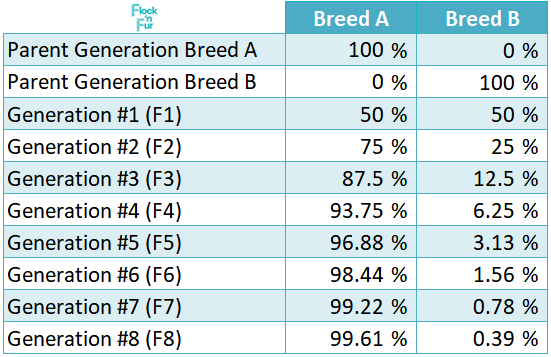Understanding Genetic Predictability in Chickens
The term “purebred” is common in poultry breeding but often misunderstood. Chickens described as purebred might still show unexpected variation due to genetic complexities, selective breeding choices, or breed-specific traits. Even with carefully selected, high-quality parents, offspring may occasionally deviate from expected standards. So, what exactly defines a chicken as “purebred,” and is this the most meaningful concept?
What Defines a Purebred Chicken?
Traditionally, a purebred chicken is one resulting from generations of selective breeding aimed at emphasising specific traits. This selective breeding significantly differentiates domestic chickens from their wild ancestors, like the Red Junglefowl. Unlike dog breeds, which typically have strict lineage controls, chicken breeds often embrace fluidity, mutations, and new variations.
In chicken breeding, mutations and the development of new breeds are common and even encouraged. For example, traits like the Frizzle and Naked Neck originated as genetic mutations in chickens. These unique characteristics were selectively bred and developed into distinct breeds. Over time, these breeds were crossed with others, creating new varieties within established breeds. This fluidity challenges the conventional idea of what “purebred” means, suggesting that maintaining breed standards and achieving genetic consistency are more relevant goals than rigid adherence to a “purebred” label.
Genetic Predictability and Stability
Genetic predictability refers to the breeder’s ability to reliably anticipate the traits offspring will exhibit based on the parents’ genetics. For example, blue feather colour in chickens is genetically predictable, but it does not produce uniform offspring. When breeding blue chickens together, you get predictable ratios:
- 50% Blue offspring
- 25% Black offspring
- 25% Splash offspring
Although not uniform, the results are predictable and stable, reflecting an inherent genetic rule rather than a flaw or inconsistency. Recognising genetic predictability as a desirable breeding goal allows breeders to more accurately define their objectives.
Selective Breeding to Establish Traits
Selective breeding introduces and refines traits within a breed. Introducing a new trait often involves crossing breeds initially and then breeding offspring back to the original breed repeatedly. Over several generations, this progressively aligns the genetics with the original breed while stabilising the new trait.
For instance, if you want to incorporate a dominant trait from Breed B into Breed A, you would start by crossing the two breeds. The first generation would be 50% Breed A and 50% Breed B. You would then select offspring that closely resemble Breed A and breed them back to Breed A. This process continues over several generations, each time selecting birds that most closely match Breed A while retaining the desired trait.
As breeding progresses, the genetic composition of each generation becomes increasingly representative of Breed A:
- Second generation: 75% Breed A, 25% Breed B
- Third generation: 87.5% Breed A, 12.5% Breed B
- Fourth generation: 93.75% Breed A, 6.25% Breed B
- Fifth generation: 96.88% Breed A, 3.12% Breed B
- Sixth generation: 98.44% Breed A, 1.56% Breed B
- Seventh generation: 99.22% Breed A, 0.78% Breed B
- Eighth generation: 99.61% Breed A, 0.39% Breed B

By the seventh or eighth generation, the chickens are nearly genetically identical to the original Breed A, except for the specific trait introduced from Breed B.
Achieving Stability and Consistency
Chickens become genetically stable when they consistently produce offspring aligned with established breed standards and traits. Stability is not about perfect uniformity but predictable outcomes. Breeders aiming for stable lines should verify consistent reproduction of desired traits over multiple generations before considering their lines established.
Avoiding Common Breeding Errors
A frequent issue in breeding is halting the refinement process too soon. Breeders might stop breeding back to the original breed once the chickens superficially resemble the breed standard, even if the genetic consistency isn’t fully established. This can result in chickens that visually align with the breed but fail to breed true, leading to inconsistencies in subsequent generations.
To prevent this, it’s crucial to focus on stabilising your breeding lines. Ensuring your birds consistently breed true to type before sharing them helps preserve the integrity of the breed, reinforcing that breeding success lies not just in appearance but also in genetic reliability.
Moving Beyond “Purebred”
Terms like “purebred” and even “standard bred” can obscure the genetic reality of chicken breeding. Rather than emphasising labels, breeders should focus on achieving genetically stable and predictable traits aligned with breed standards. Breeding programmes built on these principles contribute more effectively to breed integrity and development.
Maintaining the Integrity of Your Breeding Programme
Success in chicken breeding is best measured by genetic predictability, consistency, and adherence to breed standards. Prioritising these outcomes ensures that your chickens reliably pass on desirable traits, contributing meaningfully to the breed’s future.
